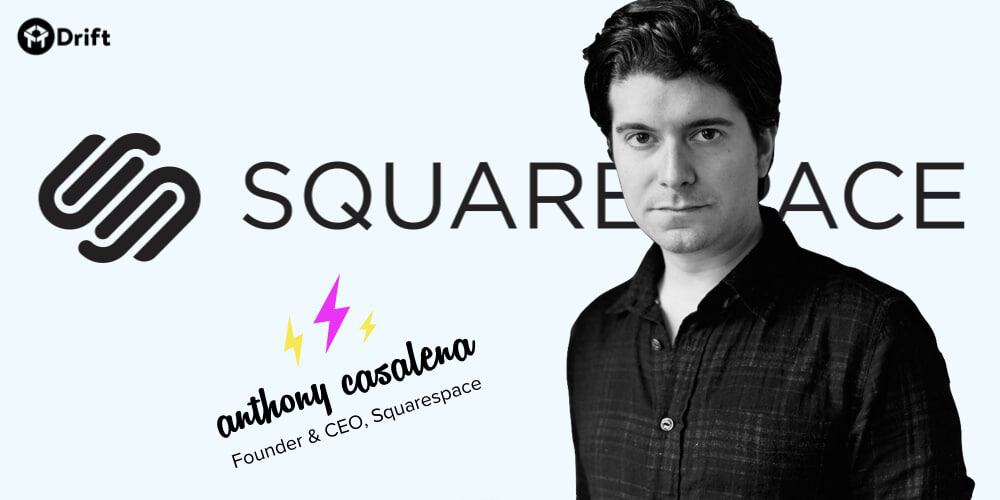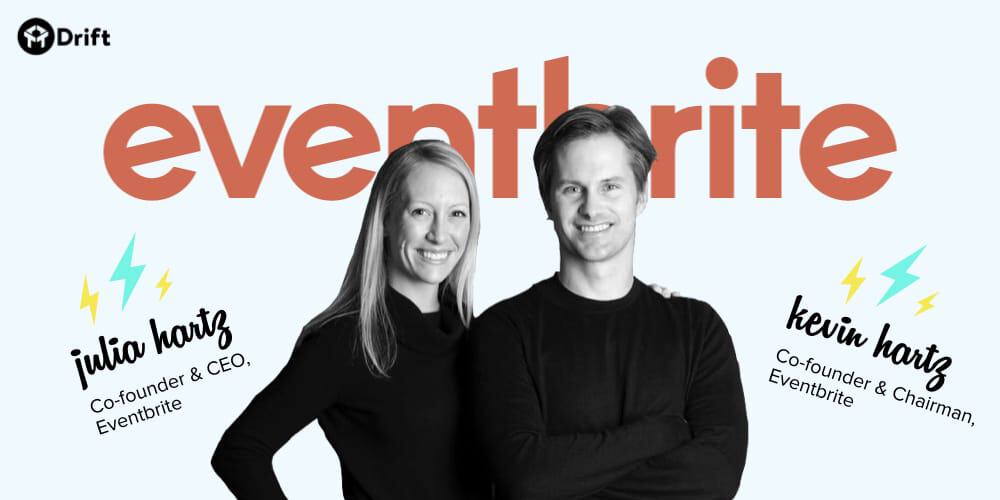
On September 20th, 2018, Eventbrite went public, selling 10 million shares and raising $230 million in its initial public offering (IPO). The company’s valuation soared to nearly $2 billion. For Eventbrite co-founders Julia and Kevin Hartz, it must have been the happiest day of their lives. I mean, apart from their wedding day… and when their children were born.
For some of us, the thought of running a business with a significant other sounds, at best, like a challenge, and at worst, like a surefire way to destroy a business, or a relationship, or both! And yet, Eventbrite CEO Julia Hartz and Eventbrite chairman Kevin Hartz have figured out how to make it work. Case in point: The online ticketing platform they launched in 2006 — with the help of technical co-founder Renaud Visage — has now processed more than $10 billion in gross ticket sales.
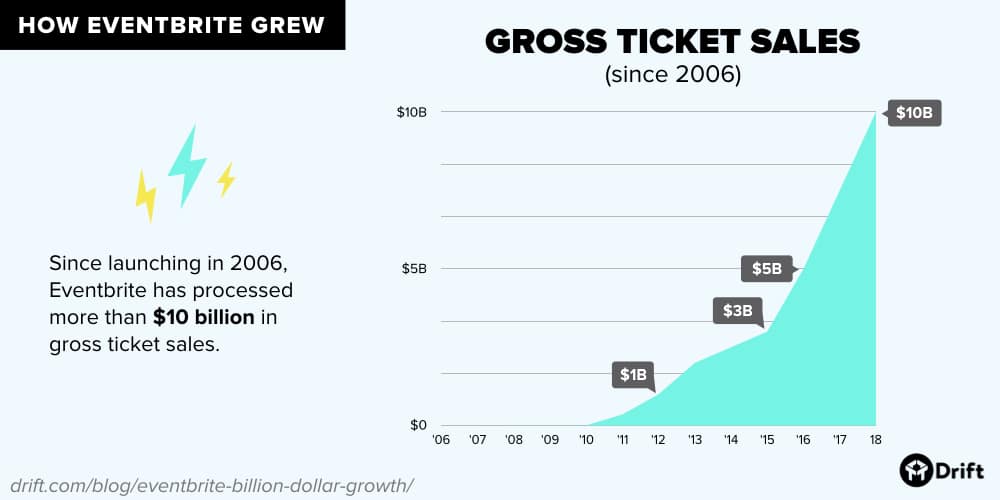
If you’re reading this post, there is a very, very good chance that you’ve used Eventbrite before, be it for registering for an event or for hosting an event of your own (maybe it was a conference, or a meetup, or a slam poetry meeting). Why are the odds so high? Just look at their ticket sales. In 2010, Eventbrite sold more than 10 million tickets via its platform. In 2015, annual ticket sales exceeded 100 million. Then in 2017, annual ticket sales exceeded 200 million.
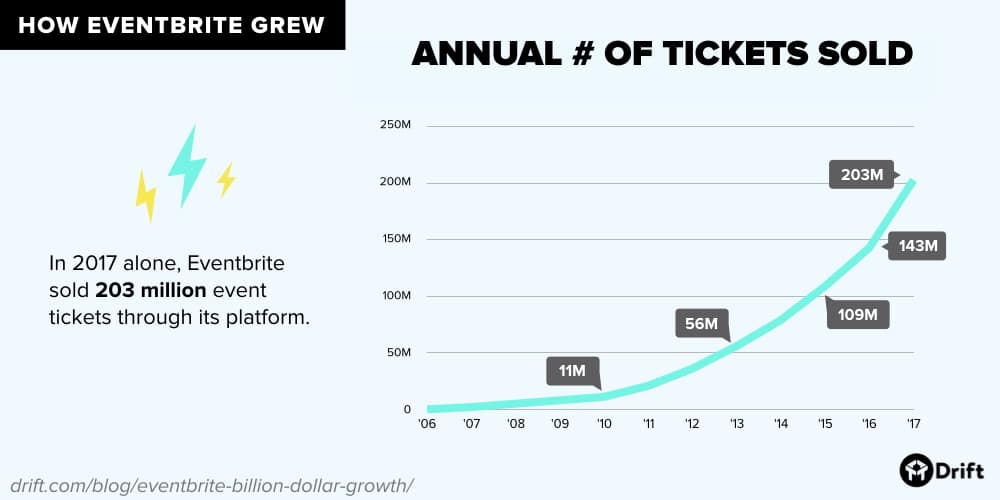
At Eventbrite, the number of tickets sold through their platform is one of their most important metrics. And that’s because it’s a metric that’s tied directly to the success of their customers (something you’ll learn more about later in this post). Of course, that’s not to say that tracking revenue isn’t important. And when you look at Eventbrite’s revenue, the numbers are similarly impressive: Eventbrite saw 51% revenue growth between 2016 and 2017. And the company’s total revenue for 2017 was $201.6 million.
So, how did Julia Hartz, a former development executive at FX Networks, and Kevin Hartz, an early investor in PayPal and co-founder of Xoom, go about creating one of the world’s most successful online ticketing companies? In this post, I’m going to share four key principles that helped Eventbrite grow.
In a hurry? Here’s the tl;dr version:
- Have a singular focus. Just because you could take your product in a million different directions doesn’t mean you should. Focus on your core goal and cut out the rest.
- Prioritize making customers successful. What’s better than adding all the bells and whistles to your product as soon as possible? Answer: Helping your customers become successful as soon as possible.
- Create a “virtuous cycle” for acquiring new customers. Remember: Your existing customers are the best marketers your company has.
- Let your company culture evolve. A company culture that’s set in stone prevents new ideas from flowing in. In order to grow, you need to attract a diverse array of opinions and viewpoints.
1) Have a singular focus.
When Eventbrite launched in 2006, the timing couldn’t have been worse. The financial crisis was just around the corner, which meant a year after Eventbrite got off the ground, it was hit with a massive lull in the economy. Business slowed down. And when co-founders Julia, Kevin, and Renaud went to raise funding from investors, all of them turned Eventbrite down. As Julia told CNBC, this was “one of the most challenging times throughout the last 10 years.”
Eventbrite had two choices: give up, or figure out a way to grow under these tough conditions. Of course, as you already know, they chose the latter option. And they were able to grow by isolating what was important and trimming the fat. To quote Julia:
If you think about stripping away 80% of the things that don’t matter and focusing on the 20% that will actually make a difference, I think you’ll find great results even in the toughest of situations and the harshest of environments.
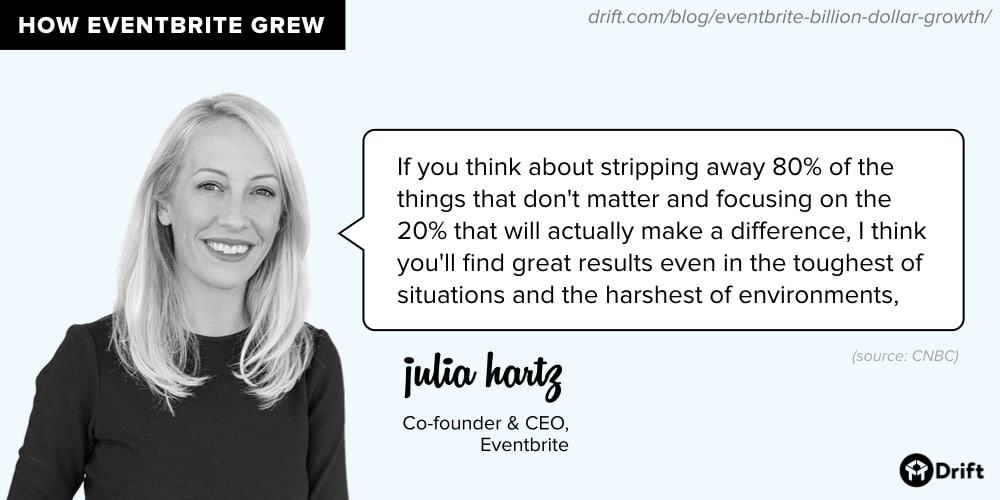
For Julia, having a singular focus is one of the most crucial and yet simultaneously most overlooked principles when it comes to growing your business. In an interview with Slush, she compared it to “being on a monorail journey, where conviction is the only thing that keeps everything going.” Julia went on to explain that “staying super focused is underrated,” and that in order to keep growing when the going gets tough, “you need to have a singular focus.”
Of course, having a singular focus is easier said than done, and it’s something that Eventbrite still struggles with. After all, with a platform like Eventbrite, there are millions of different paths to take. As Julia told Forbes:
Some of the obstacles we faced in the beginning were — and still remain our same obstacles — is focus. There are so many different ways you can take this, and yet through the tenure of Eventbrite we committed to being focused on the ticketing aspect of the event. But as you know, there are so many different things you could do on a platform, or you could create adjacent to our business, and I think it’s been a real challenge; an obstacle in itself to not get too distracted by all the possibilities.
Ultimately, Eventbrite succeeded by staying true to their core business, which in their case is ticketing. When Julia and Kevin began researching the events industry ahead of founding Eventbrite, they identified a huge gap in the ticketing market. At one extreme, there were event organizers using Ticketmaster to sell tickets to sporting events and concerts at giant stadiums, and at the other extreme there were event organizers who were managing their guest list in a spreadsheet and collecting cash at the door.
Julia and Kevin envisioned Eventbrite as the ticketing solution for everyone in between. As Julia explained to Foundr: “There was this huge gap… So we set out to build a product that was accessible and self-service to anybody who wanted to create a live experience and actually make money doing that.”
And here’s the thing: after identifying that gap, Eventbrite’s co-founders remained laser-focused on closing it. They didn’t stray into other markets or let themselves get distracted. “We could have said we’re going to go after and disrupt Ticketmaster and take their market share,” Julia told First Round Review. “Thankfully, we thought better of that,” she added.
2) Prioritize making customers successful.
Regardless of what market segment or niche your business operates in, prioritizing the success of your customers is a no-brainer. For Eventbrite, being customer-driven was one of their founding principles. From day one, they decided to tie their revenue directly to the success of event organizers. As Eventbrite’s technical co-founder Renaud Visage told Rethink, ‘When we launched we were 100% free, and then we aligned with the interests of event organizers. We decided that we were going to take a commission from tickets sold, so we only make money when our customers are successful.”
Of course, that begs the question: How do you make customers successful? And how do you make it a priority at your company?
What it really comes down to is engagement. You need to talk to customers. You need to make time for them. You need to have personal, one-on-one interactions and understand their pain points. It might sound like something that won’t scale as a skeptical executive might say, but that’s exactly why it’s worth doing.
And guess what? Helping customers is relatively inexpensive. Instead of pouring millions of dollars (which they didn’t have) into expensive ad campaigns or adding new, fancy functionality to their product, Eventbrite — partly out of necessity — prioritized picking up the phone, talking to their customers, and helping those customers sell more tickets.
As Eventbrite co-founder Kevin Hartz explained to Foundr:
[Because] we bootstrapped, we were and are extremely customer-centric…This decision has been extremely successful for us. At the end of the day, forgoing certain functionality for more customers always won out.
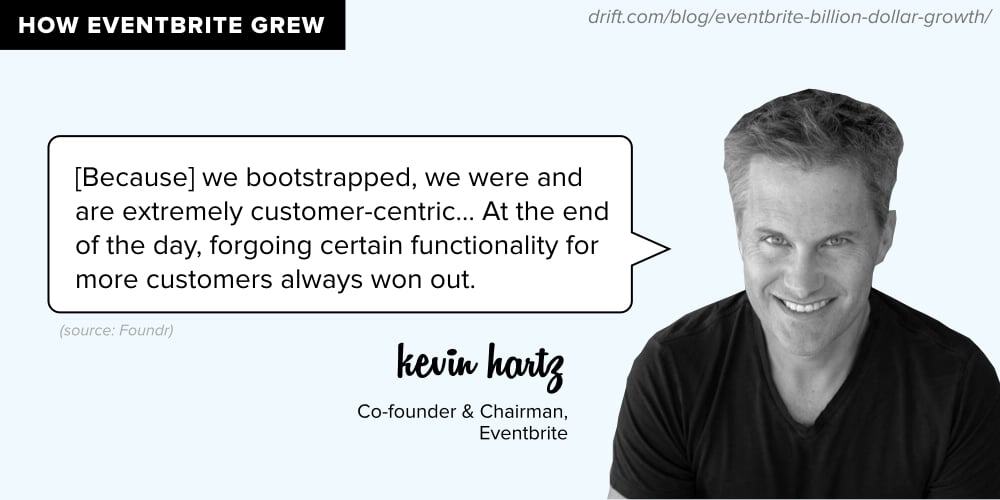
During their first two years of running Eventbrite, Julia and Kevin viewed their earliest customers almost as family members, even giving out their personal cell phone numbers so customers could reach them anytime, day or night.
“I think it’s important to be your customers’ best friend, therapist, family member,” Julia told Foundr. “I would spend countless hours on email and on the phone…We still get phone calls on our cell phones from early customers who have our cell phone numbers and who I would consider family members at this point, and I’ve never even met them.”
For Julia, prioritizing customer success means building lasting relationships, and in order to do that, you need to make time for people.
And you need to listen to them.
To quote Julia: “I think what we did was we honored what they were asking for. We unpacked their feedback, we listened, we took it all in.”
She reiterated this sentiment in a recent interview with CNN:
Our business succeeds when our event creators succeed. And the only way to help our creators succeed is by putting ourselves in their shoes so we can truly understand their unique needs.
The big takeaway here? Talk to your customers. You need to understand them in order to help them succeed.
3) Create a “virtuous cycle” for acquiring new customers.
One of the greatest benefits of being customer-driven and prioritizing customer success is that your customers end up doing the majority of your company’s marketing for you. Because when your customers succeed, they end up exposing your product to a broader audience via word-of-mouth and online recommendations.
In Eventbrite’s case, there’s an even more direct connection between customer success and marketing. By being laser-focused on helping their customers sell more tickets, more event-goers end up seeing and interacting with the Eventbrite platform. And some of those event-goers, of course, end up looking into using Eventbrite to sell tickets to their own events. And on and on this “virtuous cycle” goes. As Julia Hartz explained to Foundr:
What we realized really early on is that we had this virtuous cycle where attendees were converting into organizers, and becoming our top driver of new customer acquisition. So as long as we could pull people in to buy tickets, they would discover Eventbrite as a platform that they could use to organize events, and that actually is our number one driver of new paid customers today.
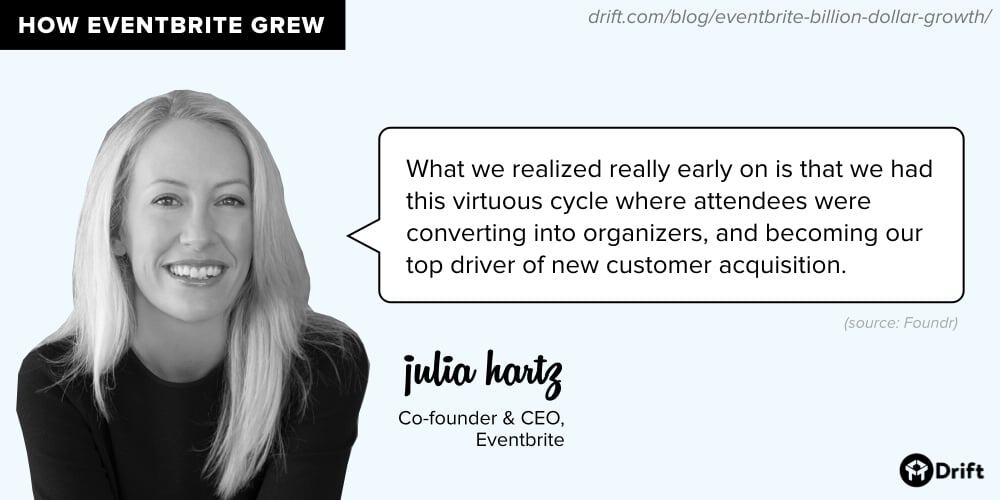
However, it’s important to keep in mind that this virtuous cycle isn’t a passive approach to customer acquisition. Especially in the early days of your company, you need to be proactive about recruiting product users who will be a good fit for what you’re offering and make sure you’re collecting (and processing) their feedback. And that’s exactly what Eventbrite did. To quote Julia:
Customer acquisition and this notion of distribution [were] absolutely probably one of the most terrifying parts of starting the company. We felt that if we could get an early adopter group to start using the product, that word-of-mouth, and sort of this virtuous cycle of people attending events and discovering the product that way, would have some impact on our business.
We were proactive in finding an early adopter group in tech bloggers who were hosting meetups. We actively onboarded them onto the platform, and not only were they active users, but they also were vocal in what they needed, and they helped us shape the product.
☝️ That’s how you create a virtuous cycle. It’s not about passively waiting for word-of-mouth around your product to take off, it’s about proactively identifying and engaging with the right audience. For Eventbrite, tech bloggers — who were prone to hosting meetups — turned out to be the perfect group for getting the word out about the product. And pretty soon everyone in the tech community began to take notice. As Julia told Forbes:
An obstacle in the very beginning was how to jumpstart the marketplace. When I think about how the questions we were being asked in the early days were really around distribution: how do you distribute your product and acquire customers?
What happened for us is that the tech community started to adopt our product, and that’s how we gained more customers, and created this network of distribution. They were our earliest adopters.
Once they succeeded in reaching the tech world, Eventbrite identified other target audiences, which included speed-dating groups and EDM (electronic dance music) fans. To quote Julia, “We were sort of following our users and then leaning into the categories where we saw traction, and that’s how we got our first thousand users.”
4) Let your company culture evolve.
In 2017, Eventbrite acquired rival online ticketing service Ticketfly in a deal worth $200 million — its biggest acquisition to date. Overall, the company has acquired 9 rival companies in 13 years. (That’s a lot of acquisitions.) And with those acquisitions came hundreds of new employees, including managers and executives.
Imagine that scenario: Workers who are your sworn (business) enemies one day are suddenly sitting next to you under the same roof the next. And now you’re expected to work together.
How did Eventbrite pull it off? Well, for starters, they always did their due diligence and learned about their future employees and what roles they would be placed in before making an acquisition. And overall, when evaluating a potential acquisition, Julia Hartz told the Financial Times that 70% of her decision is based on the “culture fit” of a potential target’s employees (while 20% is based on strategic fit and the remaining 10% is based on finances).
So, what makes a person a good culture fit for Eventbrite? According to Julia, it really isn’t all that hard to explain. As she told Foundr:
Eventbrite has been built on a few core values that are really essential to our existence, which is doing the right thing. And then really kind of basic human decency, thinking about the person first…and really drilling down on how we make people feel.
But apart from these core values (which, ideally, should be expected of all humans), Julia has been vocal about building “a flexible culture” at Eventbrite — one that’s “able to accommodate new people as they have joined.” One way Eventbrite has done this is by encouraging all of its “Britelings” (aka Eventbrite employees) to weigh-in on business decisions — including how they should decorate the office.
Understandably, people who have worked at a company for a long time get accustomed to a certain way of doing things. And when new employees come in with new ideas, and better ways of doing things, it can be hard not to let our egos get in the way. That’s especially true when it comes to hiring employees in leadership roles. As a founder, relinquishing control and accepting their ideas can be a challenge. Fortunately for Julia, she learned this lesson early in her career. As she told CNN:
I was fortunate to actually realize this pretty early on, but one of my biggest lessons was to not hire people exactly like me. The chemistry of a leadership team is incredibly important, but that doesn’t mean you all need to think and act the same. We’ve achieved success by leveraging complementary skill sets and diverse opinions.
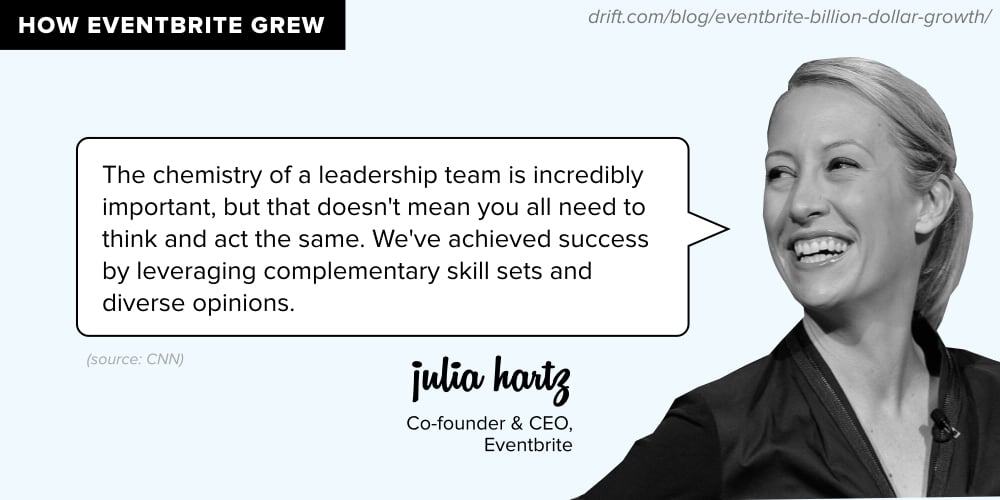
One of Eventbrite’s biggest challenges now is spreading its culture to all of its international offices. And once again, the key to success is staying flexible and being willing to adapt. As Julia told the Financial Times, a lot of U.S. companies that are expanding internationally get it wrong by focusing all of their attention on their U.S. headquarters and treating it as a cultural hub, when instead they should be treating all of their offices as equals.
To quote Julia: “We are trying to create a totally global company, which means over time, San Francisco should not be the center of the universe, right?”
Eventbrite’s Secret to Billion Dollar Growth
So there you have it: The four secrets behind how Eventbrite grew from $0 to $10 billion in gross ticket sales. And while not all of the lessons mentioned here will be directly applicable to every business, we hope that they’ll at least serve as inspiration for uncovering new ways to drive growth.
Need a quick recap of what you learned from Eventbrite? Here’s a cheat sheet:
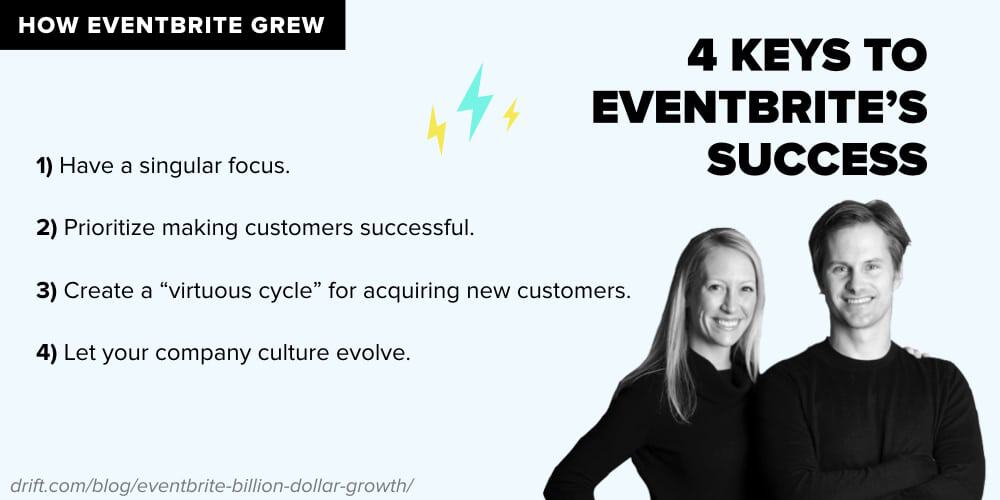
One final tidbit about Eventbrite before you go: As a result of their extraordinary brand and business growth, the company took the number 10 spot in Forbes’ 2018 Cloud 100 list, which is a ranking of the world’s top private cloud computing companies. (The list came out before Eventbrite went public, FYI.)
Want to learn more about how Eventbrite (and other Cloud 100 companies) are running their sales & marketing? Check out our 2018 Cloud 100 report.





